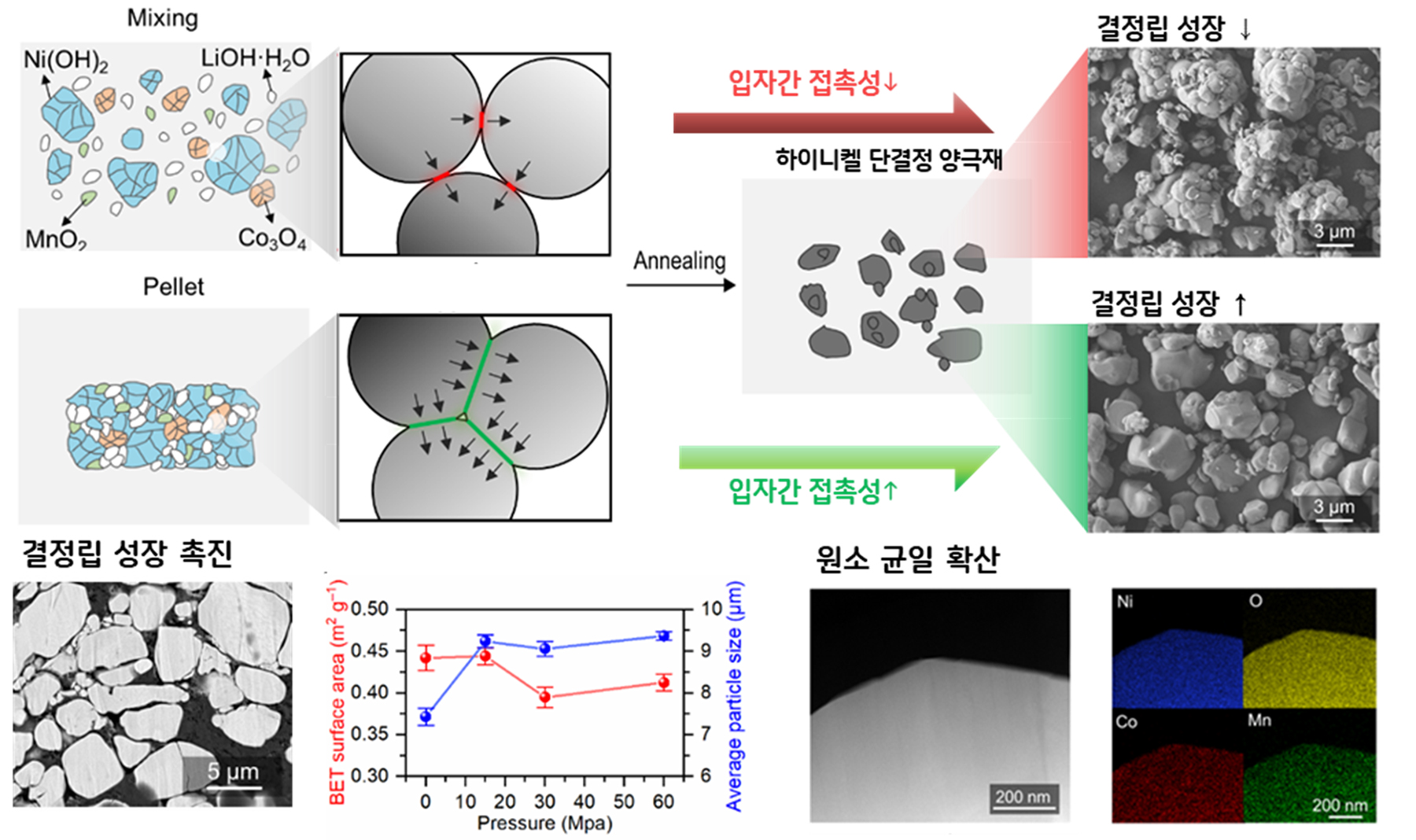커뮤니티
부경투데이
- 국립 부경대학교의 다양한 모습과 소식을 접하시면 부경대학교가 한번 더 가까워집니다.
| 새로운 양극재 합성법, 국제학술지 실렸다(Research paper on novel synthesis method for cathode material published in International journal) | |||
| 작성자 | 대외협력과 | 작성일 | 2023-05-22 |
| 조회수 | 907 | ||
| 새로운 양극재 합성법, 국제학술지 실렸다(Research paper on novel synthesis method for cathode material published in International journal) | |||||
 |
대외협력과 |  |
2023-05-22 |  |
907 |
부경대 고민성 교수, 차세대 배터리 양극재 합성법 제시
- 국제학술지 <Journal of Energy Chemistry> 게재

△ 입자 간 접촉성 향상에 따른 결정립 성장 촉진 및 원소 균일 확산 모식도.
국립부경대학교는 고민성 교수(금속공학전공) 연구팀이 이차전지 등 차세대 배터리에 사용되는 하이니켈 삼원계 ‘LiNixCoyM1-x-yO2(M=Mn or Al, x≥0.8)’ 양극재의 새로운 합성법을 제시했다고 밝혔다.
부경대 고민성 교수와 채수종 교수(공업화학과), 매사추세츠 공과대학교(MIT) 윤문수 박사와 황재성 박사(UNIST 졸업) 등으로 구성된 연구팀은 80% 니켈 조성의 하이니켈 양극재인 NCM(니켈·코발트·망간)을 전구체(precursor) 합성에 필수적으로 요구되는 공침공정 없이 단일 열처리만으로 단결정 양극재를 제작할 수 있는 새로운 건식 합성방법을 발표했다.
하이니켈 양극재는 높은 용량 구현이 가능 가격이 한 차세대 활물질로 배터리 산업으로부터 크게 주목받고 있지만, 나노 사이즈의 입자들이 구형으로 응집된 다결정 형태를 띠기 때문에 충·방전 시 입자 내부에 미세균열이 형성돼 수명 특성이 급격하게 떨어지는 문제가 있다.
현재 하이니켈 양극재를 다결정 형태가 아닌, 단결정 형태로 합성하는 여러 연구가 진행되고 있지만, 단결정 합성의 경우 원소가 불균일하게 분포하고 결정성 안정화가 어려워 성능 구현이 힘든 것으로 알려져 있다.
이같은 문제를 해결하기 위해 고 교수 연구팀은 ‘PAMD(Pelletization-assisted mechanical densification)’라는 새로운 공정을 개발해 원소 확산과 결정립 성장 속도를 향상시켰다.
그 결과 단결정 양극재 내 원소가 균일하게 분포하고, 결정성이 안정화되는 것을 확인했다. 또 미세균열 형성을 방지해 100회 충·방전 후에도 종래 다결정 양극재보다 18% 향상된 수명 특성을 보였다.
고민성 교수는 “새로운 개발 공정을 적용해 생산된 고용량의 차세대 양극재는 단가 절감이 가능할 것으로 예상되며, 리튬이차전지뿐만 아니라 전고체 배터리에도 적용할 수 있을 것으로 기대된다.”라고 밝혔다.
한편 이번 연구는 한국연구재단의 지원을 받아 이루어졌으며, 재료·에너지 분야 국제학술지<Journal of Energy Chemistry>(IF=13.599)에 지난 4월 게재됐다. <부경투데이>
Prof. Ko Min-Seong proposed new synthesis method for cathode material
- published in <Journal of energy chemistry>
Pukyong National University announced that a research team of professor Ko Min-Seong (dept. of metallurgical engineering) presented a new synthesis method for the high-nickel ternary 'LiNixCoyM1-x-yO2 (M=Mn or Al, x≥0.8)' anode material used in next-generation batteries such as secondary batteries.
The research team consisting of professor Ko Min-Seong and professor Chae Soo-Jong (dept. of industrial chemistry) from Pukyong National University, dr. Yoon Moon-Soo from the Massachusetts institute of technology (MIT) and dr. Hwang Jae-Seong (graduated from UNIST) proposed a new dry synthesis method that can produce a single crystal cathode material with only a single heat treatment without the co-precipitation process required for precursor synthesis of NCM (nickel cobalt manganese), a high-nickel cathode material composed of 80 percent nickel.
High-nickel cathode material is a next-generation active material capable of realizing high capacity and is receiving great attention from the battery industry. However, since the nano-sized particles are in the form of polycrystals in which nano-sized particles are aggregated in a spherical shape, microcracks are formed inside the particles during charging and discharging, resulting in a rapid decrease in lifespan.
Several studies are currently being conducted to synthesize high-nickel cathode materials in a single crystal form rather than a polycrystal form, but in the case of single crystal synthesis, it is known that it is difficult to implement performance due to non-uniform distribution of elements and difficult crystallinity stabilization.
To solve this problem, professor Ko's research team developed a new process called 'PAMD (pelletization-assisted mechanical densification)' to improve the diffusion of elements and the growth rate of crystal grains.
As a result, it was confirmed that the elements were uniformly distributed and the crystallinity was stabilized in the single crystal cathode material. In addition, by preventing the formation of micro-cracks, it showed 18 percent improved lifespan compared to conventional polycrystalline cathode materials even after 100 charge and discharge cycles.
Professor Ko said, "I expect that the high-capacity next-generation cathode material produced by applying the new development process will be able to reduce the unit cost, and I expect that it can be applied not only to lithium secondary batteries but also to all-solid-state batteries."
As for this research, it was conducted with the support of the National research foundation of Korea and was published in <Journal of energy chemistry> (IF=13.599), a renowned international academic journal in the field of materials and energy in April. <Pukyong Today>